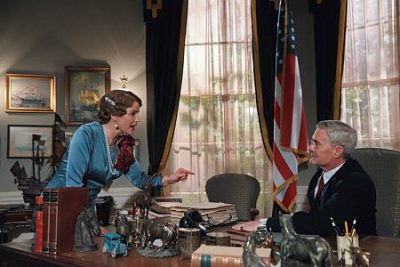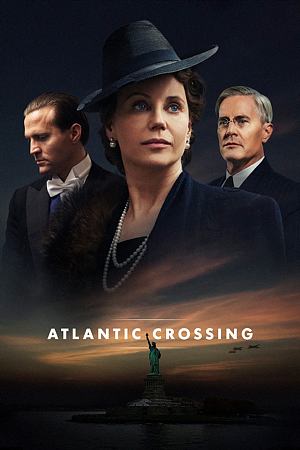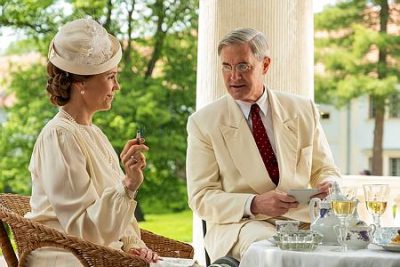An estimated 1 million Norwegians settled down in front of their televisions Sunday evening to watch the latest episode of “Atlantic Crossing,” state broadcaster NRK’s new series about Crown Princess Märtha’s exile years in the US during World War II. Viewers are drawn not only by royal glamour and dramatic war history, but also by massive public debate swirling around artistic liberties taken during the series’ production that have prompted indignant historians to brand it as “fake news.”

The series itself got off to a lukewarm start for NRK, which invested NOK 70 million in the project. Atlantic Crossing landed in ninth place during the weekend when it debuted in late October, with only around 571,000 Norwegians tuning in. Another 94,000 watched later on NRK’s own “Nett-TV,” totalling much less than even local newscasts that weekend or the popular news parody show Nytt på nytt, which garnered 835,000 viewers. Only the first two episodes of Atlantic Crossing had been released in advance, in connection with its showing at the TV festival Cannes series. NRK otherwise is carefully doling out episodes every Sunday evening, making it impossible for viewers to watch it all at once.
Now, just over halfway through its eight episodes, audiences have grown substantially, with more than 900,000 tuning in last week. The rising interest is pegged to the sudden media glare over the series, amidst charges that it’s full of factual errors allowed by producers who took too much artistic license.
Among the harshest critics are historians and authors who’ve written books about World War II and how Norway’s royal family fled the country shortly after Nazi Germany invaded on April 9, 1940. They landed in both London and Washington DC: King Haakon, Crown Prince Harald and members of the Norwegian government never surrendered to Hitler, won asylum in Great Britain and ran the country’s resistance from London. Crown Princess Märtha and the three royal children at the time (including today’s King Harald V) were literally taken in by US President Franklin D Roosevelt, after they boarded a ship in Finland’s former Arctic territory that was also carrying Americans fleeing Europe as war broke out.
Recent headlines have been merciless: ‘Atlantic Crossing’ puts NRK’s credibility in play, claimed one in newspaper Aftenposten over the weekend. False story-telling disguised as drama read another, while a commentary written by history professor Tom Kristiansen and royal biographer Tore Rem was headlined: NRK gives viewers a fundamentally untrue story.

Perhaps the most poisonous headline was on a commentary published on NRK’s own website, in English, no less: Fake history, made in Norway. It was written by another author who’s spent most of the past two decades chronicling Norway’s royal family since the monarchy was re-established in 1905. Tor Bomann-Larsen was arguably most indignant so far, accusing NRK of “unnecessarily falsifying” historic events to make them more entertaining.
At the core of all the fuss is Crown Princess Märtha’s actual role in the war, her close relationship with Roosevelt and whether she actually “changed the course of the war,” as suggested in the series’ own promotion. The debate seemed to reach a climax after last week’s episode, when Norway’s crown princess (a Swedish princess before she married her Norwegian cousin Crown Prince Olav in 1929) was all but given credit for Roosevelt’s famous “Lend-Lease Act,” approved by Congress by March 1941 and aimed at providing arms for Britain to fight off Nazi Germany. It was her personal appeals for help for her country, the series suggests, that convinced Roosevelt to stretch the limits of US neutrality at the time and lend defense supplies to Great Britain, not Winston Churchill’s.
The criticism rages on, from more banal arguments over whether the crown princess’ car really tore down a security boom at the Swedish border when she was fleeing Norway with her children in the backseat, to whether she really opened her new temporary home in suburban Maryland (that Roosevelt helped her find) to traumatized Norwegian merchant marines from vessels torpedoed in the Atlantic. That last part is true.

Those behind NRK’s series, which has been sold to scores of countries and due to be shown on PBS Masterpiece in the US next spring, staunchly defend their production, interpretation of events and artistic license. They all claim that while Norwegians know how Crown Princess Märtha made a major contribution to the war effort, and kept spirits up from abroad, she seldom won widespread recognition for her efforts. “She was asked to do things (like drum up war support among Norwegian-Americans and visit exiled Norwegians training for battle in Canada) and put a lot of effort into them, but she was never really given credit,” says Linda May Kallestein, described as a “cultural historian” and author who wrote the script for the series. “That must have been hurtful, and we base that on human psychology.”
Kallestein and the series’ creator and director, Alexander Eik of Cinenord, seem determined to shine more light on the crown princess’ role after decades of how her husband and father-in-law got most of the credit. In one scene, after Lend-Lease was enacted, Norway’s equivalent of ambassador to the US at the time raises a toast to the crown prince, while the crown princess was overlooked. Kallestein admits the scene was made up, but meant to offer the public a new view of how the crown princess exerted influence while in the US herself.
Much has been made of whether the crown princess and Roosevelt had a romantic affair during the war years. As of episode five, shown Sunday night, they’re rather portrayed as good friends and that Märtha also became a good friend of First Lady Eleanor Roosevelt. It’s factually correct that Märtha was often at the White House and that the president drove her on tours of the countryside, to get away and talk, but with the Secret Service always following close behind.
‘Not a documentary’
Eik and Kallestein have been busy defending their work over the past few weeks since the series began. They stress that it’s not a documentary but rather a “dramatization” of history,” with a good deal of “fiction” interspersed. Every episode of Atlantic Crossing starts with a written claim that it’s “inspired by true events,” and NRK is even publishing accounts on its website after every episode about what was fact and what was fiction. This week’s accounting of 10 scenes in Episode 5 admits that half were fact while the other half weren’t.
“We have never claimed that our presentation represents the truth about our royals during the war,” Eik and Kallestein wrote in Aftenposten last week. They suggest that some historians like Bomann-Larsen can’t believe that they may have dug up new information after their own six years of research into Märtha’s years in the US. They have cited a long list of their own sources, including Princess Astrid (also among Märtha’s three children who spent nearly five years in the US) and the US Presidential Library and Archives.
‘Look to Norway’
There’s also no question that Roosevelt did call on Americans to “look to Norway” for inspiration during the war. “We don’t claim she (Crown Princess Märtha) was the only one who influenced him to come up with the Lend-Lease Act,” they wrote, but she did play a role that at least won Roosevelt’s sympathy and attention.
As for how the royals themselves felt and acted, they retorted that “no one knows the full truth about everything that happened 80 years ago, so don’t tell us about the crown prince’s feelings. The truth is that you (the historians) know very little about them, as do we.” They claim they’re entitled to the liberties they took with regards to artistic license.
The series won generally poor reviews when it was first launched, so there’s no doubt that all the debate over its historic correctness has fueled interest. Its creators also issued a spoiler alert last week: “We take direct liberties in the last four episodes, too.”
NewsInEnglish.no/Nina Berglund

